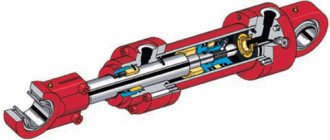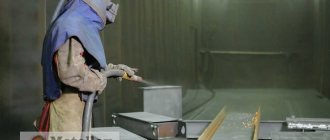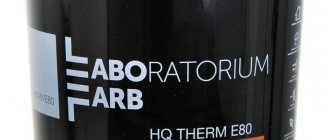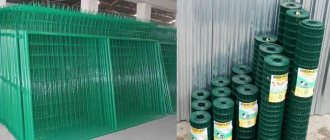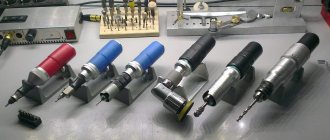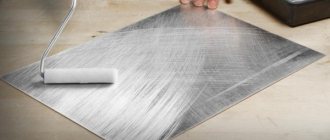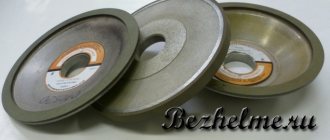An integral part of the modern production process are preparatory operations . At the preparatory stage, rough metal blanks acquire an optimal cleanliness class . Various methods can be used to clean the surface of workpieces.
Many experts agree that the most productive, efficient and rational method is shot blasting . The review will talk about the types of shot blasting machines.
“Shot blasting” is a close analogue of the sandblasting principle of surface cleaning. The difference between sandblasting and shot blasting types of processing lies only in the abrasive fraction. Sandblasting machines work with fine-grained sand, while coarse shot (Ø up to 2-3 mm) should be loaded into a shot blasting machine.
A shot blasting machine is a pressure pneumatic unit that creates a directed air flow that comes out along with the shot. Thanks to air with an abrasive suspension, the surface of metal workpieces is cleaned of corrosion and other contaminants. Shot blasting is often used to clean metal castings of slag and baked sand that forms during hot casting.
Shot blasting units are applicable when rough, raw metal workpieces are processed . Regarding “sandblasting”, it is customary to clean surfaces with a low level of contamination with a suspension of fine-grained abrasive (finishing).
How to choose shot blasting equipment.
Types of shot blasting machines
Today there are dozens of modifications of shot blasting machines. Many manufacturing companies practice the creation of unique shot blasting machines, which are developed and created individually (in a single copy), for the needs of a specific production.
Shot blasting machines can be classified according to such a parameter as “habitability”:
- Inhabited
- Uninhabited
In the case of manned equipment , an operator must be inside the processing chamber. The shot blaster is equipped with a protective suit, which gives the person the opportunity to breathe and move freely in a dangerous environment. The operator must manipulate the shot blasting gun, from which a stream of airborne abrasive suspension emerges.
Inhabited shot blasting chambers are good because the operator can manually clean some problematic, hard-to-reach places. The weakness of manned shot blasters is the use of manual labor. Because of this, the effectiveness of preparatory operations is noticeably reduced.
Regarding uninhabited chambers , such shot blasters clean workpieces in a fully automatic mode. The operator only needs to press the start button. In this case, the abrasive suspension is fed through nozzles. The position of the nozzles can be either stationary or variable.
What other types of shot blasting machines are there?
Purpose of the equipment
This equipment is designed to clean metal from rust, paint residues and other contaminants using the principle of shot throwing. This tool helps you perform the following operations:
- removes scale;
- cleans the surface from rust;
- you can create the desired roughness;
- make a matte surface;
- removes pockets of corrosion.
Using a shot blasting machine, you can extend the life of bridge supports and remove rust from structures that cannot be repaired.
Classification by degree of workflow automation
The degree of automation determines the level of human participation in cleaning workpieces. The following types of shot blasting machines are distinguished:
- Manual
- Semi-automatic
- Automatic
The speed of stripping workpieces directly depends on the degree of equipment automation.
- In completely manual models, the operator is responsible for loading the shot into the receiving hopper. After each cleaning cycle, the working chamber should be cleaned of shot and blockages. Then the fraction must be sifted. After this, clean abrasive is loaded into the hopper and the cleaning cycle is repeated.
Manual shot blasting machines are designed for infrequent and short-term use. Most often, such installations are used in small-scale production . The main advantage of manual models is their affordable price . Manual shot blasters are characterized by extremely compact dimensions and simple design.
- Semi-automatic shot blasting machines use automation of some work processes. This can be either automatic loading of shot into the hopper, or automatic sifting, or self-cleaning of the working chamber.
A certain degree of automation allows the shot blasting machine operator to save effort . At the same time, the productivity of stripping workpieces increases . Semi-automatic models have proven themselves well in both small-scale and mass production.
Of course, the presence of automation of some processes significantly affects the cost of equipment. The price of semi-automatic machines is significantly higher than the cost of manual models of similar performance. Additionally, semi-automatic machines are larger than manual shot blasters. All this is reflected in the level of repair complexity. The presence of automation significantly complicates the design of the equipment, which requires periodic maintenance and scheduled repairs.
- Automatic shot blasting machines take care of the basic processing processes. For the most part, the operator only needs to stand at the control panel and press the appropriate buttons. Fully automatic shot blasters are indispensable in serial and mass production .
Automation makes shot blasting machines incredibly productive . This reduces the percentage of shot loss. The abrasive can be used repeatedly until the fraction is completely worn out.
Of course, complete automation of technological processes makes shot blasting machines expensive, large and complex. A well-automated shot blasting line requires specially trained operating personnel.
What else do you need to know about how to choose shot blasting equipment?
Shot blasting internal pipe cleaning
The installation is designed for processing the inner surface of pipes with crushed steel shot (it is possible to work with aluminum carbide shot) and cleaning to a degree of Sa 2.5 according to ISO 8501-1 and creating a microrelief with a roughness up to Rz = (50-100) microns. The degree of processing cleanliness and surface roughness depend on the initial state of the pipe and the type of shot used. This system is also used where effective internal cleaning of drill pipes and internal cleaning of tubing pipes is needed. The dust collector collects and filters air and shot. Rust, dirt and shot worn out to an unusable state accumulate in the lower section of the dust collector and are removed to a specially designated waste area through the bottom gate.
Basic technological operations
Six pipes are simultaneously supplied to the installation for internal cleaning of pipes with a diameter of 60-114 mm, after which sealing booths are mounted on their ends. Six rods enter the pipes, and cleaning is carried out using shot, which is thrown onto the inner surface of the pipe using a stream of compressed air through nozzles. Cleaning is done on the return stroke of the rod. Simultaneously with the process of cleaning the internal cavity of the pipes, shot and dust are blown out of the pipe. The shot is returned to the elevator, sifted and reused, and the dust is filtered and collected in a dust collector.
Composition of the equipment and its description
1. Frame of the equipment for shot blasting the inner surface of pipes for installation on a flat floor without recesses and a rail track for moving carts.
Three stations for rotating six pipes with a rigid frame mounted on wheels with roller bearings driven by a frequency-controlled gearmotor. Each station is equipped with six rigid frame tube rotators, each of which is supported by elastomer-coated wheels in self-aligning roller bearings. One of the wheels is driven by a variable speed gear motor. One front boom cart made of a durable frame on which the dust collector is mounted. The trolley is mounted on wheels driven by an electric motor with a frequency-controlled gearbox. When cleaning the internal cavity of pipes, the dust collector is installed at the end of the pipe and closed with a rubber seal. A set of rubber seals is supplied for diameters 60-114 mm. 3. One driven trolley for rods, which is a frame with powerful wheels, on which three containers for pressurized shot with a volume of about 750 liters each are installed. The trolley is driven by an electric motor with a gearbox with frequency control of the speed necessary for cleaning the pipe during the return stroke of the rods. 4. Six rods with supports for pipes with a diameter of 60-114 mm. The rod is made of a thin steel pipe with increased wear resistance, at the front end of which a spray shot blasting nozzle is installed. 5. One dust collection and filtration system, including: Dust collector with rubber seals.
The abrasive is collected at the bottom of the dust collection cabinet, which has a special output system to the abrasive return conveyor. The dust collector for extracting dust and abrasives from the pipe consists of a steel casing, divided into sections in which filter cartridges are mounted. The dust collector has an installation for continuous automatic air cleaning of cartridges and is equipped with a dust collection container. — Capacity about 50,000 m3/hour — Max. Dust content in exhaust air: about 3 mg/m3. The dust collector is equipped with an automatic fire extinguishing system certified in the Russian Federation.
Abrasive recycling system
a, equipment for internal pipe cleaning, including: • One abrasive return conveyor. A conveyor approximately 30 m long transfers the collected shot from the dust collection cabinet to the recirculation system. • One recirculation tank for separating abrasive from dust and particles with a special sieve system. The elevator, which is a fibrous, durable synthetic belt with shot grips, transfers the abrasive to the recirculation system. • Clean shot goes into the shot container, contaminated shot is separated and fine dust is collected in the dust container. • One shot feed system with electro-pneumatic valve for shot dosing. • One dust filter to separate dust from the regeneration cabinet. Cartridge-type filter with installation of continuous automatic air cleaning of cartridges and a dust collection container.
— Filter capacity is about 2,500 m3/hour. — The maximum dust content in the air is 3 mg/m3.
Specifications
Shot consumption is about 150 g/m2 Shot is a mixture of crushed and round shot (the type of shot depends on the manufacturer) Compressed air consumption is about 15 m3/min for each rod at a pressure of 10 bar.
NOTES:
The difference in the length of pipes in a simultaneously processed batch of 6 pipes should be no more than 1 m. To reduce wear on the booths and maintain the chamfer of the pipes during cleaning, it is recommended to simultaneously feed pipes with a difference in length within 250 mm to the installation.
Principle of workpiece placement
Shot blasting machines can also be classified according to the principle of loading workpieces. To place blanks the following can be used:
- Fixed table
- Rotary table
- Hook hangers
The type of workpieces being processed, as well as the nature of shot blasting itself, depends on the loading principle.
- A fixed table is most often used to place fairly large workpieces. In this type, the abrasive suspension supply nozzles are located on different sides of the table. Additionally, a fixed table can also be located in habitable chambers. That is, the operator himself walks around the workpiece and cleans problem surfaces.
- The movable table is used in shot blasting machines with a one-sided nozzle. As processing progresses, the operator needs to rotate the table using the control panel, allowing access to still untreated surfaces.
Tables have one significant drawback. The surface on which the workpiece rests is not treated with abrasive. In this case, you need to stop the processing process and turn the workpiece over. Rigging operations take up valuable time.
- Hooks make it possible to hang the workpiece, which provides access to all processed surfaces. In the case of a table, the shot does not have access to the supporting surface. Hook hangers are often used for cleaning small and medium-sized workpieces. But there are also exceptions.
Construction of pass-through shot blasting plants:
- Shot blasting chamber
- Screw conveyor auger
- Electromagnetic shot dosing valves
- Shot/dust separator - drum screen/air separator
- Brush unit for removing shot residues - rotating brush with lifting/lowering block
- Shot blasters - throwers
- Bucket elevator
- Centrifugal fan
- Abrasive hopper
- Pneumatic equipment
- Filter - Dust collector
- Electrical cabinet for control equipment
Shot blasters or throwers UMD(A)-11
Throwers of our own design made it possible to produce a high-quality throwing turbine. The eight-bladed turbine allows you to clean products at speeds of up to 2.2 meters per minute. The engine with direct drive to the turbine axis can withstand high loads. These technologies make it possible to develop shot flight speeds of up to 90 m/s.
Principle of transfer of workpieces
Shot blasting chambers can operate either as part of a separate process or as part of a single technological production line. In this context, shot blasting machines can be divided into 2 categories:
- Impassable
- Passing
Non-passage chambers are blind. That is, in such shot blasting machines there is one common entrance and exit. Non-pass machines accept workpieces for processing, clean the parts and return them in the opposite direction.
Walk-through cameras use a separate entrance and a separate exit. Blanks are accepted, processed and transferred further to the next technological processes.
Conveyors serving complex technological processes have become widespread That is, the long chain drive with hook hangers can pass through the shot blasting chamber, washing and painting line . This method of transferring workpieces saves operators a lot of time and effort, since there is no need for manual loading and unloading of workpieces .
Advantages and disadvantages of application
There are a number of advantages to using shot blasting:
- If cast iron, steel or corundum shot is used, the surface is hardened.
- The increased strength of the abrasive material makes it possible to process surfaces made of homogeneous materials and alloys.
- A matte or rough surface is created if necessary.
- Effective cleaning of metal from scale, rust and other deposits.
If the installation is of an industrial type, then this significantly increases labor productivity at the enterprise. Among the disadvantages, it is worth noting that the installation does not allow cleaning in some hard-to-reach places, and the cleaning processes themselves have a low level of automation; the constant presence of an operator is required.
Alternative to shot blasting booths
Shot blasting equipment did not appear out of nowhere. This is not know-how, but a deep modernization of other equipment for abrasive processing. We are talking about shotgun devices .
The first shotguns appeared at the end of the 19th century.
Shot throwers do not use the power of compressed air. Abrasive particles are pushed out by fan blades, which are driven by an electric motor. Interestingly, classic shotguns are still available for sale even today.
The main advantage of shot blasting technology over shot blasting is its low noise level . Additionally, shotguns do not require a compressor . Cleaning workpieces using shotguns is relevant at those sites where it is undesirable to create a lot of noise, and also where there is no source of compressed air.
But when it comes to reliability, durability, and performance, shot blasting machines are far superior to shot blasters.
Main types of fractions for processing
You can regulate the metal processing mode by selecting pellets. Grit particles today are made from various materials that affect the properties of the abrasive. Let's look at the main types of pellets:
- Crushed cast iron shot. Made from cast iron, which undergoes granulation. Suitable for removing rust, carbon deposits and scale. Cast iron shot can also be used to create a matte finish and to create a slight roughness.
- Cast steel shot. Available in several varieties depending on the carbon content of the steel (thanks to this, the hardness of the pellets can be controlled). Cast steel is suitable for processing massive metal structures based on cast iron and steel (rolled steel, beams, metal structures).
- Shot based on chopped steel. Available in several varieties (pellets differ from each other in size, shape, strength, and so on). Great option for heavy-duty metal objects. The main advantage of the material is its high strength (thanks to this, the shot can be used a large number of times, which reduces the final cost of the work).
- Shots based on aluminum or aluminum alloys. Not suitable for hard iron-based alloys, but suitable for processing aluminum and various soft alloys. Aluminum shot does not deform the surface and efficiently cleans it of scale, rust, scale, and soot.
- Glass shot. In the form of heavy-duty balls that do not break or deform with frequent use, which makes the material very economical. Suitable for cleaning medium-hard metal alloys, although glass beads can also be used for cleaning iron-based alloys. The main advantage of the material is the lack of contamination.
What to consider when choosing an installation
It is immediately necessary to pay attention to what materials the installation will work with. This could be sheet metal, wire, small parts that require delicate handling. You should also take into account power parameters and design features. It is possible to use the unit individually or it requires integration into a production complex. The number of additional functions is also important.
Features of machine application
In addition to the correct choice of high-quality installation, you should know the operating features of such equipment.
Preparing surfaces for coating
Shot blasting is the optimal method to prepare any surface for subsequent coating: painting, priming, varnishing. This stops the corrosion.
Features of the work
This is an industrial metal processing that allows you to work with homogeneous metals and alloys. It is important to select the following parameters and adjust them before starting work:
- compressor power;
- abrasive particle size;
- shot material.
These parameters affect the quality of cleaning and also create the correct texture.
Safety precautions
The shot blasting machine is a source of increased danger. Therefore, safety rules must be followed:
- The compressor must be located separately from the entire installation.
- The operator must wear protective clothing, as does any person who enters the room where the shot blasting machine is operating.
- You must wear a mask when working.
Otherwise, you may be seriously injured. Shot blasting unit is equipment that allows you to clean a metal or concrete surface using shot ejected from a chamber with a strong air flow. The equipment differs in types, power and design features. It is used both in large industries and in small workshops.
